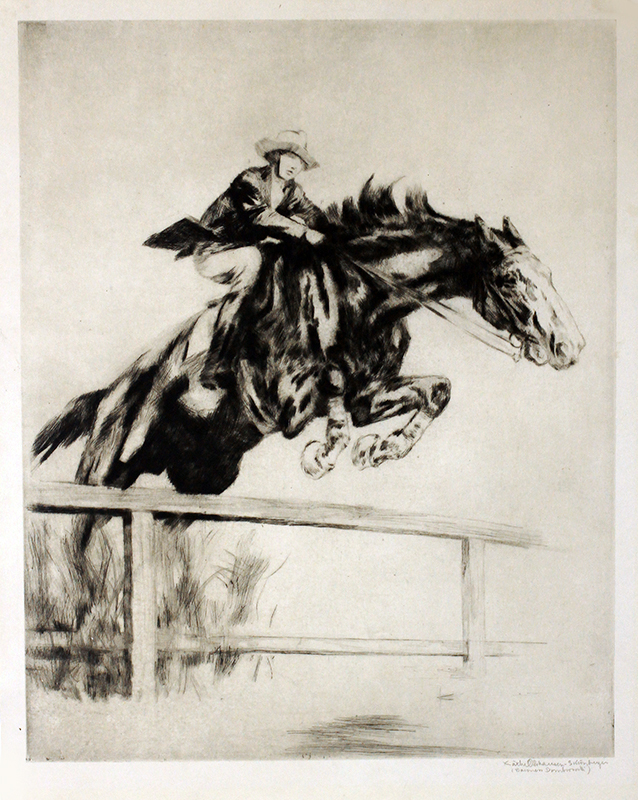
19th, 20th & 21st Century Fine Prints
707-546-7352 · fax 707-546-7924 · web: www.annexgalleries.com · email: artannex@aol.com
Taking the Fence by Baroness Kathe Olshausen-Schonberger

Taking the Fence
Baroness Kathe Olshausen-Schonberger
Taking the Fence
Baroness Kathe Olshausen-Schonberger
1881 - 1967 (biography)Artist, illustrator, author Käthe Olshausen-Schönberger was already noted for her animal caricatures by age 20, creating a series of anthropomorphised books and illustrations for children and as sly social comments. Beyond these she also created works that displayed her knowledge of the animal musculature, as displayed in this drypoint "Taking the Fence". In order to capture the drama of this action the artist used drypoint, which involves engraving directly onto the copper plate and allowing the "burr", the displaced copper, to create a kind of "furrow" and print as a dark, fuzzy line.
A horse and rider are captured in mid-air while jumping a fence. Both figures are defined by deep black shadows with the light shining off the surfaces. The fuzzy lines of the drypoint soften the surfaces, creating the feeling of the both the horse's coat and a movement to the mane. The rider's jacket lifts from the wind.
Käthe Olshausen-Schönberger was born on June 11, 1881 in Mödling, Austria as Katharina Ludovika Schönberger into a German-Jewish family. She grew up in Abbazia and moved with her family to Berlin, Germany at the age of 14. Despite never receiving a formal art education, she was already a well-known artist and illustrator by the age of twenty. Numerous drawings by the artist were first published in the German humorist magazine Fliegende Blätter (‘Flying Leaves’) and later in book form. In 1914 she received the silver medal for illustrating from the organization known as "BUGRA", in Leipzig. The term BUGRA was created from the initial letters of the words "Buchgewerbe" (book trade) and "Graphik" (graphic arts).
Beginning in 1899 she wrote and illustrated several books, including instructional manuscripts in drawing animals and on bicycle riding and horseback riding for women. She received commissions for illustrations for books and organizations, among them Fables by Gotthold Ephraim Lessing, advertisements for Cologne chocolatier Ludwig Stollwerck, and many more. She frequently used the monogram "KOS" to sign her work.
Around 1900 she married German diplomat Franz Olshausen, a German diplomat assigned to South America. Not long after their marriage they traveled throughout Paraguay, Argentina, and Brazil, and in 1903 she gave birth to her son Joern; he would later become an American biochemist. The family later lived in Berlin, Munich, Königstein in the Taunus, and in New York. Kathe and Franz divorced some time before the 1920s.
At this time she was living primarily in New York working as an illustrator as well as in film, radio plays, and as a translator of German, French, Italian, Spanish, and Portuguese. In 1922, in collaboration with Albert Einstein, Sigmund Freud, Herman Hesse, Käthe Kollwitz, Heinrich Mann, and HG Wells, she participated in Nobel Peace Prize winner Fridtjof Nansen's campaign for famine relief in post-war Russia. She remarried, to painter Carl Ritter von Dombrowski, a brief marriage that produced no children but which led to her signing her works as Katharina von Dombrowski and Baroness Dombrowski during their union.
Beginning in 1930 she published numerous novels, short stories and essays. In 1933, she tried to publish her novel In the Land of Women - Tale of a Lost Nation, a fictional account of the second president of Paraguay, Francisco Solano Lopez, who waged South America's most devastating war on the people of Brazil, Argentina, and Uruguay from 1864 to1870. Strongly anti-military and anti-dictatorship, she intentionally attempted to coincide the novel's publication with the looming rise of Nazi Germany. However, the book wasn't published until two years later, and only in England and the United States.
Olshausen-Schönberger lived in the United States from 1925 to 1951 before returning to Austria. Baroness Käthe Olshausen-Schönberger von Dombrowski died on December 31, 1967 in Graz, Styria, Austria.


